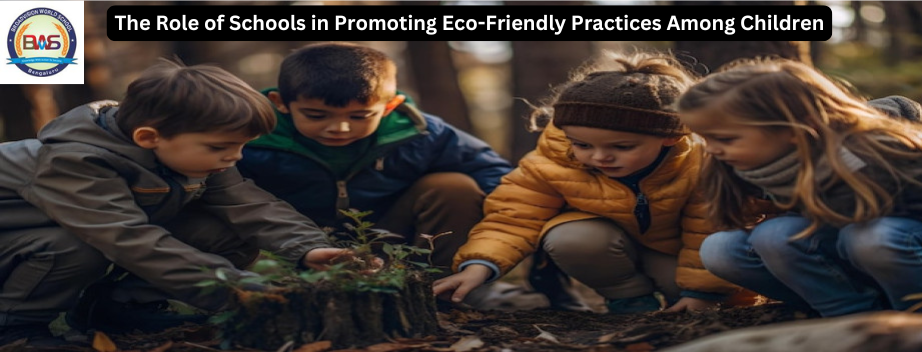Giving your child the best start in life
-
First Floor, 10A Chandos Street London New Town W1G 9LE
Get In Touch
Monday to Friday: 8.30am – 02.00pm
Saturday, Sunday: Close
Email: user@domainname.com
Phone: +44 (0) 207 689 7888

In today’s world, where climate change and environmental degradation are pressing issues, the importance of Eco-Friendly Practices cannot be overstated. Schools play a crucial role in nurturing an environmentally conscious generation. By incorporating sustainable practices into their curricula and day-to-day activities, schools can significantly impact how children view and interact with their environment.
So, what exactly are eco-friendly practices? These are actions that contribute to preserving the environment and minimizing harm to it. Examples include reducing waste, conserving energy, using renewable resources, and promoting biodiversity. Teaching children about these practices not only benefits their immediate community but also helps foster a sense of responsibility toward the planet.

Schools are more than just places for academic learning; they are the breeding grounds for lifelong habits. When children learn about sustainability early on, they are more likely to carry these practices into adulthood. Imagine a world where every student leaves school with a solid understanding of how their choices impact the environment!
One effective way to promote Eco-Friendly Practices is by integrating environmental education into various subjects. Whether it’s science classes discussing ecosystems, art classes focusing on recycling materials, or math classes calculating carbon footprints, the possibilities are endless. Project-based learning—like creating a school garden—can also engage students in hands-on eco-friendly practices.
Speaking of hands-on activities, schools can encourage eco-friendly habits through initiatives like gardening programs, where students can learn about growing their own food. Setting up recycling initiatives—like paper and plastic drives—can teach children about waste management while encouraging them to think critically about their consumption habits.
The physical environment of schools also plays a role in promoting Eco-Friendly Practices. Implementing sustainable infrastructure, such as solar panels, energy-efficient lighting, and rainwater harvesting systems, can serve as real-world examples for students. Green spaces and outdoor classrooms not only enhance learning but also foster a connection to nature.
Schools can amplify their impact by partnering with local organizations to promote eco-awareness. Hosting events like Earth Day celebrations, clean-up drives, and workshops can engage students, parents, and the broader community in sustainability efforts. When schools act as community hubs for environmental education, they inspire collective action.
Another way to promote Eco-Friendly Practices is by empowering students to become leaders in sustainability. Schools can establish clubs focused on environmental initiatives, giving students the opportunity to lead projects, organize events, and create awareness campaigns. This not only boosts their confidence but also instils a sense of ownership over their environmental impact.
In our digital age, technology can be a powerful ally in promoting eco-friendly education. Schools can utilize apps and online platforms to track and reduce their carbon footprints, engage students in virtual learning about sustainability, and connect with other eco-conscious institutions around the globe. E-learning can expand the reach and effectiveness of environmental education.
However, promoting Eco-Friendly Practices in schools isn’t without its challenges. Funding and resources can often be limiting factors. Additionally, there may be resistance from staff, parents, or the community, particularly if change is perceived as disruptive. Navigating these challenges requires a concerted effort from educators, parents, and policymakers.
There are numerous examples of schools successfully implementing eco-friendly practices. For instance, schools that have adopted zero-waste policies or those that incorporate comprehensive environmental curricula have shown measurable improvements in student engagement and community involvement. These success stories serve as inspiration for other institutions looking to make a change.
Parents can play an essential role in supporting their child’s eco-friendly education. Encouraging eco-friendly habits at home—like composting, recycling, and conserving water—reinforces what students learn in school. Additionally, parents can collaborate with teachers and school administrators to advocate for more environmental education initiatives.
Looking ahead, we can expect to see more innovations in sustainability education. With the growing importance of environmental literacy, schools will increasingly incorporate sustainability into their mission and vision. As educators embrace new teaching methods and technologies, eco-friendly practices will likely become an integral part of the learning experience.
Waste reduction has become a pressing concern, especially in educational institutions where large quantities of waste are generated daily. Implementing a zero-waste policy in schools not only promotes environmental stewardship but also instills sustainable habits in students. This article explores various strategies that schools can adopt to effectively implement a zero-waste policy.
What is Zero Waste?
Zero waste is a philosophy that encourages the redesign of resource life cycles so that all products are reused. The goal is to divert as much waste as possible from landfills and incineration.
Importance of Zero Waste in Schools
Schools are ideal candidates for zero-waste initiatives due to their capacity to influence young minds. By fostering a culture of sustainability, schools can significantly reduce their environmental impact while promoting responsible citizenship.
Assessing Current Waste Levels
Promoting Digital Solutions
Encouraging digital tools in schools helps reduce paper waste. Here’s how:
By using these digital solutions, schools can significantly reduce paper use and promote sustainability.
Rethinking Food Waste
To minimize food waste in school cafeterias, schools can implement these strategies:
By adopting these practices, schools can effectively reduce food waste and promote sustainability.
Setting Up Recycling Stations
What It Is:
Recycling stations are bins placed around the school for students and staff to easily recycle items like paper, plastic, metal, and glass.
Why It’s Important:
Making recycling simple encourages everyone to participate, reducing waste and keeping the school clean.
How to Set It Up:
Composting Organic Waste
What It Is:
Composting is turning food scraps and yard waste into compost, a natural fertilizer for gardens.
Why It’s Important:
Composting reduces landfill waste and creates nutrient-rich soil for plants.
How to Start Composting:
By implementing recycling stations and composting, schools can promote sustainability, reduce waste, and engage students in caring for the environment.
Incorporating Waste Reduction into the Curriculum
Hosting Workshops and Events
By integrating waste reduction into the curriculum and organizing engaging events, schools can foster a culture of sustainability and encourage students to take responsibility for the planet.
Partnering with Local Organizations
Schools can work with local environmental groups to access resources and expertise for their zero-waste programs. These organizations can provide recycling and compost bins, offer expert advice, and run workshops for students and staff. By organizing community events together, schools can raise awareness about reducing waste and build a support network for sustainability efforts.
Involving Parents and Guardians
Involving parents is key to the success of zero-waste initiatives. Schools should communicate their goals through newsletters and meetings, encouraging families to adopt similar practices at home, like using reusable bags and composting. Organizing workshops for parents and inviting them to participate in school events fosters community involvement. Creating parent committees focused on sustainability allows for shared ideas and support, strengthening the school’s zero-waste efforts.
Monitoring Progress
Making Adjustments
By monitoring progress and adjusting strategies based on feedback, your zero-waste program can continuously improve, making it more effective and engaging for everyone involved.
Recognizing Achievements
Recognizing achievements in waste reduction is essential for motivating students and staff. When the school meets goals—like recycling a certain amount of paper or reducing food waste—celebrate these successes in various ways:
Celebrating these milestones fosters pride and motivation in the community.
Sharing Success Stories
Once achievements are made, share them to inspire other schools to adopt similar waste reduction efforts:
By sharing these success stories, the school not only celebrates its achievements but also encourages others to take action for a more sustainable future.

By teaching children these Eco-Friendly Practices, we can help them develop habits that reduce waste, conserve resources, and protect the environment. These small actions, when practiced regularly, have a significant positive impact on the planet.
In summary, Broadvision World School Plays a vital role in teaching Eco-Friendly Practices and fostering a commitment to sustainability. By incorporating environmental education, hands-on learning, and community involvement, they can shape future generations to care for the planet. Implementing a zero-waste policy in schools helps reduce waste, promotes recycling, and teaches students valuable sustainability lessons. Though challenging, the rewards of a healthier environment and more responsible students make it a worthwhile effort.
Schools can start by reducing paper usage through digital assignments, setting up recycling and composting programs, promoting reusable materials, and incorporating environmental education into the curriculum. Simple initiatives like creating school gardens or organizing clean-up drives can also make a significant impact.
Parents can reinforce eco-friendly habits at home by practicing recycling, composting, and reducing waste. They can also engage with teachers and school administrators to advocate for environmental education initiatives and participate in school events focused on sustainability.
A zero-waste policy encourages reducing waste to the point where no trash is sent to landfills. Schools can implement this by conducting waste audits, promoting digital solutions to minimize paper waste, establishing recycling and composting programs, and engaging students and staff in sustainability initiatives.
Teaching sustainability in schools fosters environmental awareness and responsibility among students. By instilling eco-friendly practices early on, schools help students develop lifelong habits that contribute to a healthier planet and promote responsible citizenship in their communities.
Schools often face challenges such as limited funding and resources, resistance to change from staff or parents, and the need for ongoing training and education. Overcoming these challenges requires collaboration among educators, parents, students, and the community to create a supportive environment for sustainability initiatives.

Comments are closed